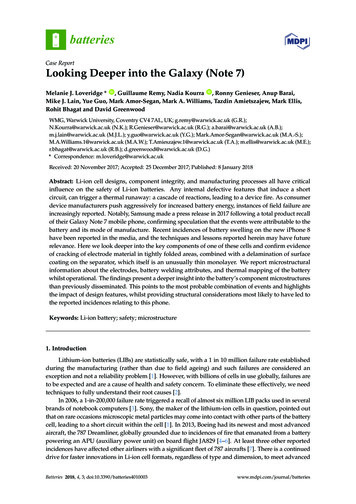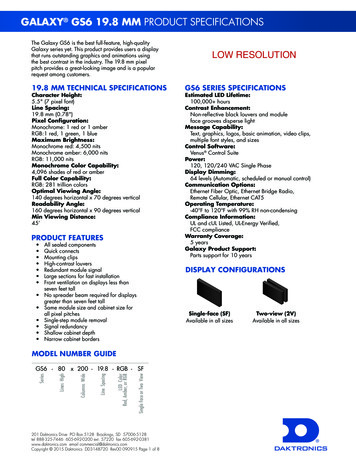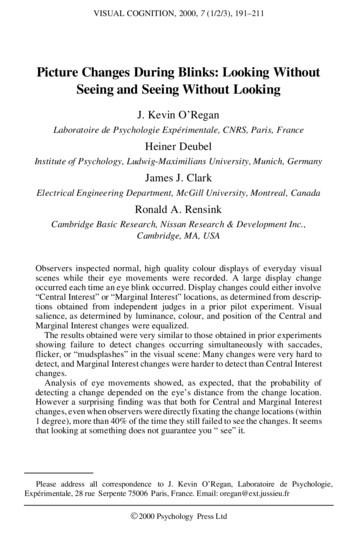
Transcription
batteriesCase ReportLooking Deeper into the Galaxy (Note 7)Melanie J. Loveridge * ID , Guillaume Remy, Nadia Kourra ID , Ronny Genieser, Anup Barai,Mike J. Lain, Yue Guo, Mark Amor-Segan, Mark A. Williams, Tazdin Amietszajew, Mark Ellis,Rohit Bhagat and David GreenwoodWMG, Warwick University, Coventry CV4 7AL, UK; g.remy@warwick.ac.uk (G.R.);N.Kourra@warwick.ac.uk (N.K.); R.Genieser@warwick.ac.uk (R.G.); a.barai@warwick.ac.uk (A.B.);m.j.lain@warwick.ac.uk (M.J.L.); y.guo@warwick.ac.uk (Y.G.); Mark.Amor-Segan@warwick.ac.uk (M.A.-S.);M.A.Williams.1@warwick.ac.uk (M.A.W.); T.Amieszajew.1@warwick.ac.uk (T.A.); m.ellis@warwick.ac.uk (M.E.);r.bhagat@warwick.ac.uk (R.B.); d.greenwood@warwick.ac.uk (D.G.)* Correspondence: m.loveridge@warwick.ac.ukReceived: 20 November 2017; Accepted: 25 December 2017; Published: 8 January 2018Abstract: Li-ion cell designs, component integrity, and manufacturing processes all have criticalinfluence on the safety of Li-ion batteries. Any internal defective features that induce a shortcircuit, can trigger a thermal runaway: a cascade of reactions, leading to a device fire. As consumerdevice manufacturers push aggressively for increased battery energy, instances of field failure areincreasingly reported. Notably, Samsung made a press release in 2017 following a total product recallof their Galaxy Note 7 mobile phone, confirming speculation that the events were attributable to thebattery and its mode of manufacture. Recent incidences of battery swelling on the new iPhone 8have been reported in the media, and the techniques and lessons reported herein may have futurerelevance. Here we look deeper into the key components of one of these cells and confirm evidenceof cracking of electrode material in tightly folded areas, combined with a delamination of surfacecoating on the separator, which itself is an unusually thin monolayer. We report microstructuralinformation about the electrodes, battery welding attributes, and thermal mapping of the batterywhilst operational. The findings present a deeper insight into the battery’s component microstructuresthan previously disseminated. This points to the most probable combination of events and highlightsthe impact of design features, whilst providing structural considerations most likely to have led tothe reported incidences relating to this phone.Keywords: Li-ion battery; safety; microstructure1. IntroductionLithium-ion batteries (LIBs) are statistically safe, with a 1 in 10 million failure rate establishedduring the manufacturing (rather than due to field ageing) and such failures are considered anexception and not a reliability problem [1]. However, with billions of cells in use globally, failures areto be expected and are a cause of health and safety concern. To eliminate these effectively, we needtechniques to fully understand their root causes [2].In 2006, a 1-in-200,000 failure rate triggered a recall of almost six million LIB packs used in severalbrands of notebook computers [3]. Sony, the maker of the lithium-ion cells in question, pointed outthat on rare occasions microscopic metal particles may come into contact with other parts of the batterycell, leading to a short circuit within the cell [1]. In 2013, Boeing had its newest and most advancedaircraft, the 787 Dreamliner, globally grounded due to incidences of fire that emanated from a batterypowering an APU (auxiliary power unit) on board flight JA829 [4–6]. At least three other reportedincidences have affected other airliners with a significant fleet of 787 aircrafts [7]. There is a continueddrive for faster innovations in Li-ion cell formats, regardless of type and dimension, to meet advancedBatteries 2018, 4, 3; atteries
Batteries 2018, 4, 32 of 11performance criteria. We propose that effective component characterisation is critical over multiplescales if we are to meaningfully interpret and reduce failure rates.Batteries 2018, 4, 32 of 11Within Li-ion cells an internal short circuit can generate sufficient heat to initiate exothermicside reactionsinvolvingenergydense andsometimesvolatilecomponentsthe cell—whencharacterisationis criticalover multiplescalesif we are tomeaningfullyinterpretwithinand reducefailuretheserates.proceed out of control they cause a thermal runaway resulting in fires [8]. Additional electrical,WithinLi-ion cellsan internalshort circuitsufficientheatatoreactioninitiate exothermicmechanical,or thermalabuseconditionsmay canalsogeneratecontributeto suchcascade insidecertainreactions involvingenergy denseandsometimesvolatilewithinLi-ionthe cell—whencircumstancesand be associatedwiththermalrunawaytocomponentsadversely affectcells [9]. theseproceed out of control they cause a thermal runaway resulting in fires [8]. Additional electrical,mechanical,or thermalCascadeabuse conditions may also contribute to such a reaction cascade in certain1.1. TheThermal Runawaycircumstances and be associated with thermal runaway to adversely affect Li-ion cells [9].The primary functional components of a lithium-ion cell are the anode and cathode (each takingthe formof aThermalmetallicfoil coatedwith electrochemically active components) and electrolyte (typically1.1. TheRunawayCascadea liquid organiccompound). During the charge process Li ions move from the cathode through theThe primary functional components of a lithium-ion cell are the anode and cathode (each takingseparatortotheelectronsflow through anexternalcircuit.andCausesof shortcircuitingthe form of a anode,metallic whilstfoil coatedwith callymay eigncontaminantsorLi-dendritespenetratingorganic compound). During the charge process Li ions move from the cathode through thethroughthe separator(an insulatingporousfilmthroughseparatinganode circuit.and cathode).Anythingthat resultsseparatorto the anode,whilst electronsflowan externalCauses ofshort circuitingmay be contactexternal betweenor internal.anodeThe latterincludecontaminantsor circuit.Li-dendrites penetratingin electricaland maycathode[10]foreignwill resultin a shortthroughseparator availability,(an insulatinga porousand cathode).AnythingthatPriorto thecommercialbatteryfilmwillseparatingundergo aanodeformationcycle. Thisallowsfor e[10]willresultinashortcircuit.creation of a protective layer on the electrodes, generated from the decomposition of a small amountPrior to commercial availability, a battery will undergo a formation cycle. This allows for theof electrolytesolution on the surface of the electrodes. This is termed the ‘solid electrolyte interphase’creation of a protective layer on the electrodes, generated from the decomposition of a small amount(SEI). Following a short circuit event the localised temperature inside the cell begins to rise and atof electrolyte solution on the surface of the electrodes. This is termed the ‘solid electrolyte interphase’100 (SEI).C theFollowingSEI film abeginsto decompose [11]. A series of exothermic reactions follow between SEIshort circuit event the localised temperature inside the cell begins to rise and at 100compoundsandelectrolytesuchas ethylenecarbonate(EC)and diethyl(DEC). C the SEI film begins tosolventsdecompose[11].A series ofexothermicreactionsfollow carbonatebetween SEIWhencompoundsthis cascadereactionsproceedsit causesrapidelevationof ed,as ethylene wherebyseriesof reactionscangenerate largevolumesof flammableWhen thiscascadeaofreactionsproceedsuninterrupted,it causesa rapidelevation hydrocarbonof the internalgases,temperaturewherebya series of reactionsgenerate large volumes of flammable hydrocarbonwhichwill vent toatmosphere—seeFigure 1 can[12–15].gases, which will vent to atmosphere—see Figure 1 [12–15].Figure1. A summarythe thermalrunawaycascadeof reactionsthatplacetake insideplace ainsideaFigure1. A summaryof theofthermalrunawaycascadeof reactionsthat ture.cell as a function of temperature.Cathode oxide materials can reduce in exothermic disproportionation reactions e.g., lithiumCathodeoxidematerialscan inreducein exothermicdisproportionationreactionse.g., lithiumcobalt oxidebreakdownoutlinedEquation(1) [13,16]. ChargedLixCoO2 (lithiated)can decompose,cobaltreleasingoxide (lithiated)canx complete2oxygen at elevated temperatures [17]. Equation (1) shows thereduction todecompose,cobaltreleasingelevated[17]. agentEquation(1) showsthe[16].complete reduction to cobaltmetaloxygenthat willatonlyoccur iftemperaturessufficient reducing(solvent)is presentmetal that will only occur if sufficientreducing agent (solvent) is present [16].2Li0.5CoO2 LiCoO2 Co. O2 (1)2Li0.5 CoO2 LiCoO2 Co. O2 (1)
Batteries 2018, 4, 33 of 11Therefore, in the context of the continued widespread use of this cathode material, it willpotentially be problematic only when conditions warrant thermal stability, as compared with e.g.,lithium iron phosphate [18]. The choice of electrode chemistries is often a question of energy densityvs. rate requirements and such things can often result in trade-offs that dictate ultimate performance.Investigating and understanding the root causes of cell failures allow us to re-engineer the waycells are constructed or manufactured to then mitigate the safety hazards [19] associated with thelikelihood of internal short circuits in LIBs. It is not straightforward to capture all failure origins inbatteries as they are closed systems. Operando characterisation techniques have become a populararea in battery research and are proving to be very valuable. They allow us to measure or visualiseoccurrences in real-time, without stopping operation and opening the battery. This is a very highpriority and active area within the energy storage research community [20].1.2. How was Battery Manufacturing the Cause of the Faults?In 2016 there was a total product recall of the Samsung Galaxy Note 7 which has cost the companyan estimated 17 billion [21], with the reported cause of the fire incidences claimed to be attributableto a “non-optimized manufacturing process relating to the battery”. The official investigation bySamsung highlighted several key areas to which the phone fires were attributed. The errors reportedwere both in the design and manufacturing of the batteries and were reported to include:(i) Insufficient insulation material within the batteries;(ii) Not enough room to safely accommodate the battery;(iii) Welding burrs on the positive electrode resulting in penetration of the insulating tape (on thetabs) and separator.Additional independent investigations by three organisations; UL, Exponent, and TÜV—Rheinland analysed hundreds of cells and added more insight into root cause analysis and abuseapproaches [22]. Their respective press releases expanded on the suspected failure modes reportedfrom the two battery companies—Manufacturers A and B—used to supply the cells for the Note7 manufacture.1.3. Reported Failure Suspicions and Battery Component CausesTwo additional press releases presented investigations of batteries from two differentmanufacturers [22,23]. Cells from Manufacturer A and B were described in the root cause analysesreports, citing that the thermal failure events were due to unintended anode deformation in the cornerof the cell closest to the negative tab. Cells from Manufacturer B were reported to have no suchdeficiencies but were reported to contain welding defects tall enough to bridge the distance to theanode tab. Additionally, insulating tape was found to be missing over the cathode electrode tab.The second investigation tested 10 devices containing cells from Manufacturer A alongside 10from Manufacturer B and summarised the suspected causes of the thermal failures as a combination of:(i)(ii)(iii)(iv)(v)(vi)Internal short circuit (ISC) at the upper right corner of the cells;Repeated deformation of the separator at corner locations;Missing insulating tape on the cathode tab;Poor alignment of components;Uneven charge status and;Thinner separator compared with others used in previous devices.This study seeks to corroborate the reported findings by elucidating—across multiple scales—allthe microstructural aspects inside the battery but to add to the component and material-level detailsand resolution. We capture deeper analysis of key components compared with the press releasesissued. Several dimensional levels will be considered.
Batteries 2018, 4, 3Batteries 2018, 4, 34 of 114 of 112.2. Results and DiscussionDiscussion2.1.2.1. ElectrochemicalElectrochemical CharacterisationCharacterisationFigureFigure 2a2a showsshows thethe temperaturetemperature profileprofile (maxima(maxima andand minima)minima) asas aa functionfunction ofof chargingcharging fthechargingstep,thetemperatureofthecellwith periodic thermal imaging. For the duration of the charging step, the temperature of the cell diddid C at a charging rate of C/2.notnot riserise aboveabove 3232 Cat a charging rate of C/2. C can be seen across the cell from top to bottom.AA noticeablenoticeable temperaturetemperature differencedifference ofof upup toto 33 Ccan be seen across the cell from top to erminalThe higher temperature side is where the positive terminal isis sitedsited andand thisthis isis wherewhere currentcurrent adeof aluminium,whereastheoccurs ntcollectorscollectorsthiselectrodemadeof 1andthe anode current collectors are made of copper. Cu and Al have dif
of their Galaxy Note 7 mobile phone, confirming speculation that the events were attributable to the battery and its mode of manufacture. Recent incidences of battery swelling on the new iPhone 8 have been reported in the media, and the techniques and lessons reported herein may have future relevance. Here we look deeper into the key components of one of these cells and confirm evidence











